Tim Bruening - Fab Academy 2016
Week #16 - Interface and Applications Programming
In the sixteenth week we were tasked with creating code to
interface with an input &/or an output.
Here is a list of tasks as I see them for the sixteenth week.
- Choose one of my previous PCBs to experiment with
- Interpret the code and edit it to change the outputs or
interpret the inputs differently.
- Have fun.
- Document the process and list any problems encountered.
Choose a previous PCB to work with.
I choose to work with the hello.temp.45.py circuit from week eleven.
This board has an FTDI interface. I will be able to see the
results on the PC.
The following is the modified version of the original file.
I highlighted items in red that I will discuss further.
I used standard strikethrough/underline methods to show what I removed
or added to the file.
-------------------------------------------------
#
# hello.temp.45.py
#tim.py
#
# receive and display temperature
# hello.temp.45.py serial_port
#
# Neil Gershenfeld
# CBA MIT 3/27/12
#
# (c) Massachusetts Institute of Technology 2012
# Permission granted for experimental and personal use;
# license for commercial sale available from MIT
#
from Tkinter import *
from numpy import log
import serial
WINDOW = 600 # window size
eps = 0.5 # filter time constant
filter = 0.0 # filtered value
def idle(parent,canvas):
global filter, eps
#
# idle routine
#
byte2 = 0
byte3 = 0
byte4 = 0
ser.flush()
while 1:
#
# find framing
#
byte1 = byte2
byte2 = byte3
byte3 = byte4
byte4 =
ord(ser.read())
if ((byte1 == 1)
& (byte2 == 2) & (byte3 == 3) & (byte4 == 4)):
break
low = ord(ser.read())
high = ord(ser.read())
value = 256*high + low
if (value > 511):
value -= 1024
V = 2.5 - value*5.0/(20.0*512.0)
R = 10000.0/(5.0/V-1.0)
#
NHQ103B375R5
# R25
10000 (O)Document the process and list any problems
encountered.
# B (25/85) 3750 (K)
# R(T(C)) =
R(25)*exp(B*(1/(T(C)+273.15)-(1/(25+273.15))))
B = 3750.0
R25 = 10000.0
T =
1.0/(log(R/R25)/B+(1/(25.0+273.15))) - 273.15
F=(T*(9.0/5.0))+32
filter = (1-eps)*filter + eps*F
x = int(.2*WINDOW +
(.9-.2)*WINDOW*(filter-20.0)/10.0)
canvas.itemconfigure("text",text="%.2f"%filter)
canvas.coords('rect1',.2*WINDOW,.05*WINDOW,x,.2*WINDOW)
canvas.coords('rect2',x,.05*WINDOW,.9*WINDOW,.2*WINDOW)
canvas.update()
parent.after_idle(idle,parent,canvas)
#
# check command line arguments
#
if (len(sys.argv) != 2):
print "command line: hello.temp.45.py serial_port"
sys.exit()
port = sys.argv[1]
#
# open serial port
#
ser = serial.Serial(port,9600)
ser.setDTR()
#
# start plotting
#
root = Tk()
root.title('hello.temp.45.py (q to exit)')
root.bind('q','exit')
canvas = Canvas(root, width=WINDOW, height=.25*WINDOW,
background='white')
canvas.create_text(.1*WINDOW,.125*WINDOW,text=".33",font=("Helvetica"
"times",
24),tags="text",fill="#0000b0"
"#b22222")
canvas.create_rectangle(.2*WINDOW,.05*WINDOW,.3*WINDOW,.2*WINDOW,
tags='rect1', fill='#b00000' '#d8bfd8')
canvas.create_rectangle(.3*WINDOW,.05*WINDOW,.9*WINDOW,.2*WINDOW,
tags='rect2', fill='#0000b0' '#dda0dd')
canvas.pack()
root.after(100,idle,root,canvas)
root.mainloop()
---------------------------------------------------------------------------------------
EDIT #1
The first edit was the name of the file: tim.py. You can also see the original colors
and fonts of the temperaure window.
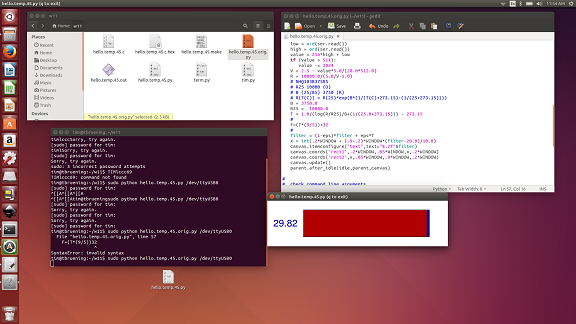
COMMENT #1
#
NHQ103B375R5 This
is the serial number of the chip used in the example.
#
R25
10000 (O) At 25°C the chip will have 10K ohms of
resistance.
COMMENT #2
T =1.0/(log(R/R25)/B+(1/(25.0+273.15))) - 273.15
The first part of this formula
calculates degrees Kelvin. subtracting 273.15
converts it to celsius.
EDIT #2
F=(T*(9.0/5.0))+32
This formula I inserted converts the
Celsius into Fahrenheit. The value in "F"
is sent to the readout box.
When this formula was first inserted I entered 9/5 and the readouts
were incorrect.
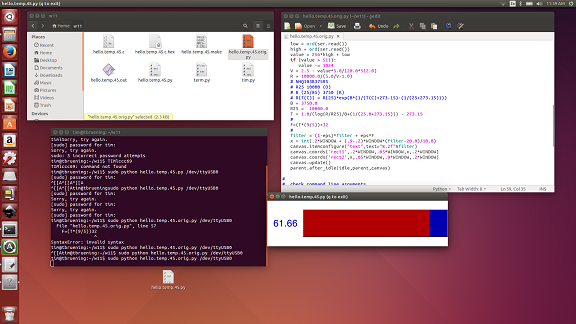
It was discovered that the formula turned 9/5 into 1.0. The value was
truncated.
When I entered the formala as 9.0/5.0 it was turned into 1.8, the
correct
value was then displayed in the box.
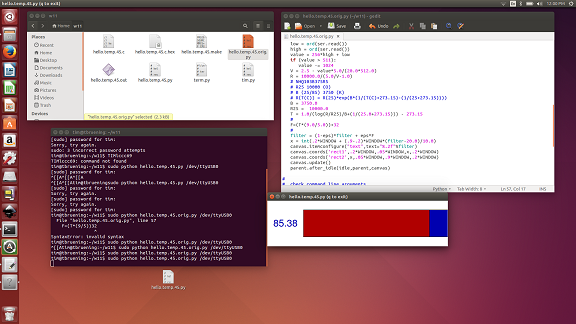
EDIT #3
"Helvetica"
"times" Here
I changed the font from
Helvetica to Times.
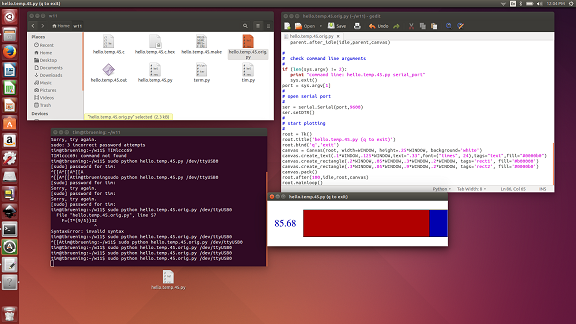
EDIT #4
"#0000b0"
"#b22222" This changes
the text color from Blue
to Firebrick.
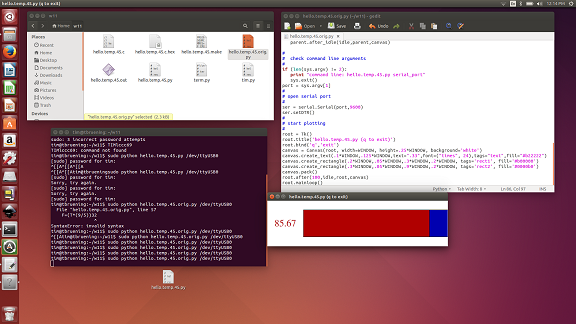
EDIT #5
'#b00000' '#d8bfd8' This changes
the left box color from Red to Thistle.
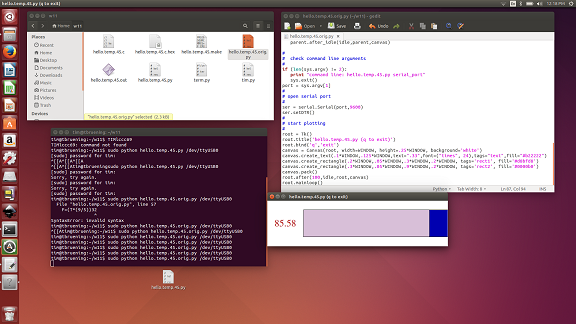
EDIT #6
'#0000b0' '#dda0dd' This changes
the right box from Blue to Plum.
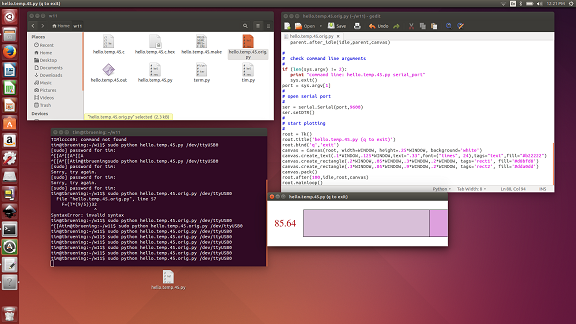
Document the process and list any problems encountered.
The only problem I ran into was the one I discussed about the
truncating of values when a whole number instead of a decimal is
inserted into a formula.
In general I did have a bit of fun learning some of the
meanings of the codes that we are working with. This should
help me with my final programming.
Here is my "Hero shot" of the final appearance of the circuit.
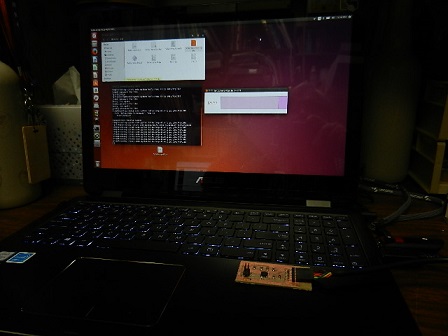
Tim's Files:
Color Files
Blue color chart showing
hex equivalent
Red color chart showing
hex equivalent
Python Files
Original Python file
Tim's Python file
Back to index







